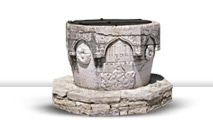
- Sečovlje Salt Pans - Dragonja River Valley
- Sv. Peter - Nova vas - Padna
- Pomjan - Nature Park: Karst Edge - Socerb
- Črni Kal - Osp - Kubed
- Momjan - Grožnjan - Pietrapelosa - Mirna
- Baštija - Kostanjica - Parenzana
- Oprtalj - Završje - Livade - Zrenj
- Istarske toplice - Motovun Forest - Višnjan
- Cave Mramornica - Feštini Kingdom - Cave Baredine
- Lim Bay - Kloštar - Kontija - Dvigrad
- Kanfanar - Bale - Palud - Vodnjan -Islands Brijuni - Fažana
- Svetvinčenat - Tinjan - Pićan - Gračišće
- Belaj - Šumber - Kožljak - Paz
- Čepićko Field - Kršan - Boljun Castle - Lupoglav
- Plomin - Kvarner Gulf - Brseč
- Nature park Učka - Mošćenice
Kanfanar - Bale - Palud - Vodnjan -Islands Brijuni - Fažana
Kanfanar
Although numerous finds from prehistory – the Neolithic culture, Bronze Age tumuli, remains of Iron Age hill-forts, parts of settlements of ancient Histri on seven locations – create a multi-layered story about the first and later life in Kanfanar, in historic recordings the most striking is the story about the close ties between Kanfanar and Dvigrad. It was an inseparable bond, from as early as the Middle...
More

Bale
It is a town of turbulent past, standing on the hill Mon Perin. On the remains of a prehistoric hill-fort, the Romans built a fortification Castrum Vallis. Historic documents, remains of Roman edifices, bronze coins and other finds prove that Bale fortification protected salt pans and sections of the Via Flavia leading from Pula to Poreč, from frequent incursions of neighboring inhabitants from the...
More

Palud
The only ornithological park in Istria lies between Rovinj and Bale. The swamp developed by melting of the ice and flooding of karst valley, and was mostly filled with fresh water from the source and smaller flows nearby and the surrounding forests and pastures. In the rainy period it covers an area of 20 hectares, while in the dry period it is considerably smaller - only two hectares, with knee-deep water.
More
Vodnjan
Traces of life in this area are observed already in prehistoric times: on Castelliere Hill above Vodnjan are the ruins of a prehistoric hill-fort.
When the Romans conquered Istria in 177 BC, land was given to the most meritorious soldiers. The area of Vodnjan was given to the soldier after whom the town was named Attinianum. A castle already existed at the time, a fortified and strategically...
More

Brioni
One of the most beautiful national parks in Croatia, the place where history in combination with natural beauties created gorgeous scenery, leaving every visitor speechless. In the past, just like today, it is equally impressive and overwhelming.
The Brijuni Islands covering an area of 33.9 sq kilometers are separated from the mainland by the 3-kilometer-wide Fažana Channel. The archipelago, consisting of 14...
More

Fažana
Its development was greatly determined by the Brijuni Islands as the nearest port. As early as the 1st c. the production of amphorae in this area was of great importance. The famous imperial Via Flavia that connected Trieste with Pula, passed by Fažana. In ancient documents Fažana is mentioned as a diocese which in the beginning of the 11th c., by the king's deed of gift became the possession of the bishops of Pula. It...
More
 Print page Send to a friend
Print page Send to a friend















